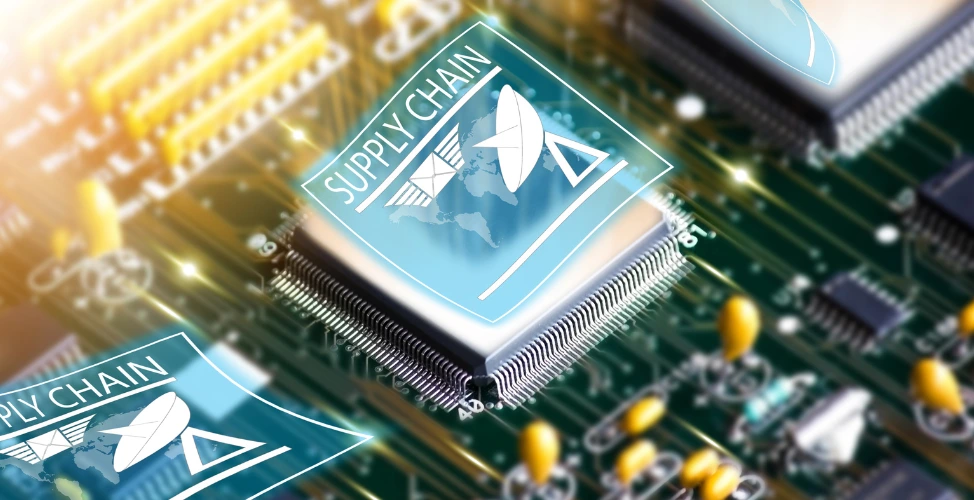August 17, 2021
How AI-Powered Supply Chains Are Revolutionizing Logistics
Supply chain management is undergoing a radical transformation, and artificial intelligence is at the heart of it. The ai-powered supply-chain is rapidly becoming the new standard, allowing businesses to move beyond reactive logistics into predictive, autonomous, and insight-driven operations. Traditional supply chains often fall short due to demand unpredictability, delayed inventory updates, and siloed systems that hinder visibility. In contrast, AI-enhanced logistics can anticipate disruptions, automate decisions, and create a connected, real-time view of the supply chain network. SmartOSC helps enterprises unlock these possibilities by designing intelligent supply chain ecosystems that enhance transparency, adaptability, and operational efficiency through AI technologies.

Highlights
- AI-powered supply chains combine machine learning, real-time analytics, and generative models to enhance decision-making at every supply chain layer.
- Key benefits include demand forecasting, dynamic routing, inventory automation, and risk evaluation.
- SmartOSC partners with businesses to build scalable, AI-enabled logistics platforms that deliver measurable value and resilience.
What Is an AI-Powered Supply Chain?
An AI-powered supply chain is a modern, technology-driven logistics ecosystem that integrates artificial intelligence into every stage of the supply chain lifecycle, from procurement and production to warehousing, transportation, and last-mile delivery. Unlike traditional supply chains that rely heavily on manual processes and static decision rules, AI-powered supply chains leverage data, automation, and machine intelligence to operate more dynamically, predictively, and efficiently.
At its core, an AI-powered supply-chain system transforms raw data into actionable insights. It continuously ingests data from various sources such as IoT sensors, ERP systems, CRM platforms, GPS trackers, and external feeds like weather reports or economic indicators. These inputs are processed in real time to provide supply chain stakeholders with full visibility into operations and to support fast, context-aware decisions.
Key capabilities of AI-powered supply chains include:
- Predictive Analytics: These systems anticipate future events, such as demand surges, supply shortages, or transportation delays, by analyzing historical patterns and external signals. For instance, AI can forecast product demand across regions and SKUs, enabling proactive inventory allocation and production planning.
- Intelligent Automation: AI algorithms automate routine logistics decisions like reordering stock, choosing optimal delivery routes, managing restocking thresholds, and scheduling warehouse labor. This reduces human error, speeds up processes, and ensures consistency across the supply chain.
- Real-Time Anomaly Detection: AI models continuously monitor logistics operations to detect and alert teams to anomalies, such as late shipments, machine breakdowns, or unusual demand patterns, enabling swift responses that minimize disruptions.
- Data-Driven Decision-Making: Instead of relying on spreadsheets or static dashboards, AI-powered platforms provide adaptive, scenario-based decision tools. These tools help logistics leaders simulate outcomes, evaluate trade-offs, and implement smarter strategies.
Ultimately, the ai-powered supply-chain acts as a digital nerve center for logistics, combining foresight, automation, and optimization to enhance responsiveness, reduce costs, and build resilience in an increasingly volatile global environment. In practice, companies using AI in their supply chains have seen a 12.7% drop in logistics costs and a 20.3% reduction in inventory levels, according to McKinsey’s 2025 report.
Core Technologies Behind AI in Supply Chains
The effectiveness of an AI-powered supply-chain lies in its ability to synthesize vast, complex datasets and respond in real time to changing market conditions. This capability is made possible by a combination of advanced technologies that underpin the intelligence, adaptability, and automation of modern logistics systems. Here’s a closer look at the core technologies driving AI transformation in the supply chain industry:
Machine Learning and Predictive Analytics
Machine learning (ML) models form the analytical backbone of AI-powered supply chains. These algorithms process massive amounts of historical and real-time data to identify hidden patterns, trends, and correlations. When applied to areas such as demand forecasting, lead time prediction, and inventory optimization, ML enables businesses to:
- Anticipate demand spikes based on seasonal trends or promotional campaigns.
- Predict potential disruptions caused by supplier issues, geopolitical risks, or natural disasters.
- Optimize procurement and replenishment cycles to reduce stockouts and excess inventory.
Predictive analytics helps decision-makers shift from reactive to proactive planning, improving supply chain resilience and cost-efficiency.
Computer Vision for Warehouse and Quality Control
Computer vision, a subset of AI focused on interpreting visual data, is revolutionizing warehouse operations and product quality management. By analyzing video feeds and images captured by cameras, drones, and mobile devices, computer vision systems can:
- Track inventory movement in real time and identify bottlenecks on warehouse floors.
- Conduct visual inspections to detect damaged goods, mislabeling, or incorrect packaging.
- Monitor worker safety and compliance with operational protocols.
By incorporating a layer of visual intelligence, autonomous AI agents can dramatically improve the accuracy and speed of warehouse logistics. These agents process and interpret visual data in real time, reducing the need for manual audits and enabling more efficient, error-free operations.
Generative AI and Large Language Models (LLMs)
Generative AI technologies, powered by advanced LLMs like GPT and Claude, are now being applied to transform communication-heavy and decision-intensive parts of the supply chain. These systems can:
- Automatically parse and review complex procurement contracts, reducing legal bottlenecks.
- Simulate alternative sourcing and delivery scenarios to support contingency planning.
- Analyze supplier health by extracting insights from unstructured data sources such as emails, news articles, reviews, and financial reports.
By blending natural language processing with machine reasoning, generative AI introduces a new level of intelligence and flexibility into supply chain decision-making.
Together, these technologies create a robust foundation for the ai-powered supply-chain, enabling enterprises to streamline operations, respond to change with agility, and unlock new levels of efficiency and visibility across their global logistics networks.
See more: Traditional AI Explained: How It Compares to Generative AI Today
Key Benefits of AI in Supply Chain and Logistics
Implementing an AI-powered supply-chain brings far-reaching benefits that go beyond automation, it redefines how businesses anticipate demand, manage risk, and optimize logistics. With intelligent systems embedded into every layer of the supply chain, organizations can unlock significant efficiencies, cost savings, and resilience. Below are the core advantages:
- Real-Time Visibility and Risk Detection: AI connects data from ERP, logistics, and third-party systems to give businesses real-time visibility into their supply chain. Whether it’s shipment delays or supplier inconsistencies, AI models detect anomalies early and recommend adjustments before disruptions escalate.
- Demand Forecasting and Inventory Optimization: AI algorithms forecast demand at the SKU and regional level based on seasonality, promotions, and macroeconomic conditions. This enables smarter purchasing decisions, reduces holding costs, and helps prevent stockouts or overstocking, leading to healthier margins.
- Route Optimization and Delivery Automation: AI analyzes factors such as weather, road closures, and traffic congestion to dynamically update delivery routes. It enhances last-mile efficiency and ensures customer SLAs (Service Level Agreements) are met without delays.
- Supplier Evaluation and Cost Reduction: Using historical data and AI-driven scoring models, businesses can assess supplier performance and identify risks. These insights help reduce procurement costs, streamline contract negotiation, and cut waste from logistics pipelines.
Use Cases of AI-Powered Supply Chains in Action
The impact of an AI-powered supply-chain is being felt across industries, from retail to manufacturing and healthcare, where precision, speed, and adaptability are crucial. Below are real-world examples of how AI technologies are transforming logistics, fulfillment, and operations across different sectors.
- Retail and eCommerce Logistics: AI enables personalized fulfillment by predicting shopping trends and automating restocking. For example, during peak holiday seasons, AI systems dynamically adjust warehousing operations and delivery routes to meet increased demand, ensuring on-time delivery and minimal stockouts.
- Manufacturing and Distribution: AI supports just-in-time production by optimizing raw material sourcing, automating purchase orders, and forecasting production needs. In case of disruption, generative AI can suggest alternative suppliers or routes, reducing operational downtime.
- Healthcare and Pharmaceuticals: In this critical sector, AI is used for cold-chain logistics to ensure temperature-sensitive products like vaccines are stored and transported properly. AI also predicts inventory usage based on hospital data, ensuring supplies are available during demand surges.
Challenges in Implementing AI in Supply Chains
Despite the transformative potential of an ai-powered supply-chain, deploying AI across logistics and operations presents several critical challenges. Organizations must overcome technical, structural, and cultural barriers to fully realize the benefits of AI-driven supply chain modernization.
- Data Silos and Integration Barriers: Many enterprises struggle with fragmented data across outdated systems. Without unified platforms or consistent governance, AI models may lack the necessary context to make accurate predictions. Integration with cloud-based data lakes and structured APIs is essential for AI success.
- AI Skills Gap and Change Management: Deploying an ai-powered supply-chain requires both technical knowledge and cultural change. Companies need skilled data scientists, AI engineers, and supply chain analysts. Equally important is ensuring alignment across leadership and operational teams to drive adoption.
See more: Understanding the AI Process: From Data Collection to Decision-Making
How SmartOSC Powers AI-Powered Supply Chain Solutions
SmartOSC helps businesses reimagine supply chain infrastructure by integrating AI at the core of logistics operations. Each solution is tailored to the company’s industry, size, and digital maturity.
SmartOSC’s AI supply chain capabilities include:
- Scalable cloud architecture for real-time data processing
- Machine learning pipelines for demand planning and automation
- Generative AI for risk analysis, sourcing strategy, and contract review
- System integration with existing ERPs, WMS, and logistics tools
SmartOSC collaborated with a multinational electronics brand to implement an AI and Data Analytics-powered delivery routing system across Southeast Asia. By analyzing real-time data such as traffic conditions, weather patterns, and warehouse capacity, the AI system dynamically optimized delivery routes for maximum efficiency.
Within the first quarter, the solution reduced delivery delays by 30% and significantly improved fuel efficiency across the brand’s regional fleets. This initiative highlights how intelligent logistics powered by data-driven insights can drive both operational excellence and sustainability.
FAQs: AI-Powered Supply-Chain
How does AI improve supply chain resilience?
Artificial intelligence significantly strengthens supply chain resilience by enabling real-time monitoring, predictive analytics, and adaptive planning. Through continuous analysis of live data from logistics networks, suppliers, and demand signals, AI identifies potential disruptions, such as delays, shortages, or geopolitical risks, before they escalate. This proactive approach allows businesses to reroute shipments, reallocate inventory, or switch suppliers swiftly, minimizing downtime and maintaining service continuity. An ai-powered supply-chain becomes not only reactive but anticipatory, turning uncertainty into opportunity.
What AI technologies are commonly used in logistics?
The backbone of an ai-powered supply-chain consists of several advanced technologies. Machine learning (ML) is used to uncover demand patterns and optimize supply flows. Predictive analytics helps forecast lead times and inventory needs. Computer vision is deployed in warehouses for automated scanning, quality checks, and visual tracking. Natural language processing (NLP) enables AI to read invoices, contracts, and customer emails. More recently, generative AI and large language models (LLMs) are being used for tasks like contract summarization, supply risk analysis, and intelligent customer interaction. Together, these technologies create a holistic intelligence layer across the supply chain.
Can small and mid-sized enterprises use AI in their supply chains?
Absolutely. The democratization of AI has made it accessible to small and mid-sized enterprises (SMEs) through affordable cloud-based tools, Software-as-a-Service (SaaS) platforms, and modular AI solutions. SMEs no longer need massive infrastructure investments to benefit from AI. With minimal upfront costs, they can implement features like demand forecasting, real-time tracking, and automated inventory management, customized to their scale. SmartOSC, for example, helps businesses of all sizes design scalable ai-powered supply-chain ecosystems tailored to growth and flexibility.
What’s the ROI of investing in an AI-powered supply-chain?
The return on investment (ROI) from adopting an ai-powered supply-chain varies by use case and maturity level, but the benefits are consistently compelling. According to recent industry studies, AI can reduce logistics costs by up to 15%, improve inventory accuracy by 20–30%, and cut delivery times substantially through better route planning and automation. Additional value comes from improved customer satisfaction, faster decision-making, and reduced waste. Over time, these compounding efficiencies translate into stronger margins and a competitive edge in increasingly volatile global markets.
Conclusion
The ai-powered supply-chain is no longer a futuristic concept, it’s a business imperative. As global supply chains become more complex and customer expectations rise, traditional systems simply can’t keep up. AI brings the speed, insight, and flexibility required to compete in today’s fast-moving world. With SmartOSC as your AI partner, your supply chain becomes smarter, faster, and more resilient, ready to tackle challenges and seize opportunities in real time. Contact us now!
Related blogs
Learn something new today


